Megaplan has long been a popular Russian tool for task and sales management, yet by 2025 more and more teams are searching for flexible, visual, and secure replacements. Some companies are tired of the dated interface, others worry about being tied to a single Russian data center, and many run into limited integrations. The market now offers a wide array of cloud services with advanced automation, built-in reporting, and honest “all-in-one” pricing. This article reviews ten platforms often considered a Megaplan alternative, weighs their pros and cons, and helps you choose a system that fits your business goals.
Why Are Users Looking for Megaplan Alternatives?
The first complaint from teams leaving Megaplan is the lack of solid visual tools. The Kanban board is rudimentary, the Gantt chart feels clunky, and customizable dashboards with graphs are missing entirely. Second, feature expansion depends on a closed widget catalog, so integrations with popular messengers or cloud storage arrive slowly. Third, large projects suffer from scalability issues — performance drops noticeably once you exceed 50,000 tasks, and file storage is pricier than many international rivals. Finally, companies working with foreign clients prefer neutral data centers and global security certificates, which Megaplan does not yet provide. All these factors push businesses to search for a “Megaplan alternative” with better UX, an open API, and multi-currency deal support.
Criteria for Choosing a Modern CRM / Task Manager
Before migrating, outline your priorities:
- Task management: Do you need Kanban, lists, Gantt charts, and calendars — or just one view?
- CRM module: Are full sales pipelines, multichannel outreach, automation bots, and client segmentation essential?
- Project scale: How many tasks must the system handle without slowing down?
- Integrations: Are ready-made connectors available for telephony, messengers, payment gateways, 1C, or BI tools?
- Reporting: Do you need end-to-end analytics, time tracking, and financial ROI reports, or is a basic burn-down chart enough?
- Cost: Most platforms bill “per user per month,” but some — Worksection, for example — offer flat rates “per team,” which can save money as you grow.
- Security: Look for TIER III+ data centers in the EU/USA, ISO 27001 certification, and at-rest encryption.
Best Megaplan Alternatives for 2025
Worksection
Worksection stands out because every core tool is included in the base plan: Kanban boards, a Gantt chart, a shared calendar, a built-in time tracker, and granular access rights. When a task is created, the team can attach files, checklists, and deadlines and immediately log time. This is ideal for agencies and studios that bill hourly without relying on third-party trackers. A major plus is the straightforward pricing model: in 2025 the “Business” plan costs €49 for a team of up to 25 people, with tiered upgrades that avoid per-user surcharges. Clients or contractors can be invited for free and limited to the projects you choose. The interface is available in English, Russian, and Ukrainian; mobile apps cover iOS and Android; and data is hosted in ISO-certified AWS-EU facilities — eliminating regulatory concerns.
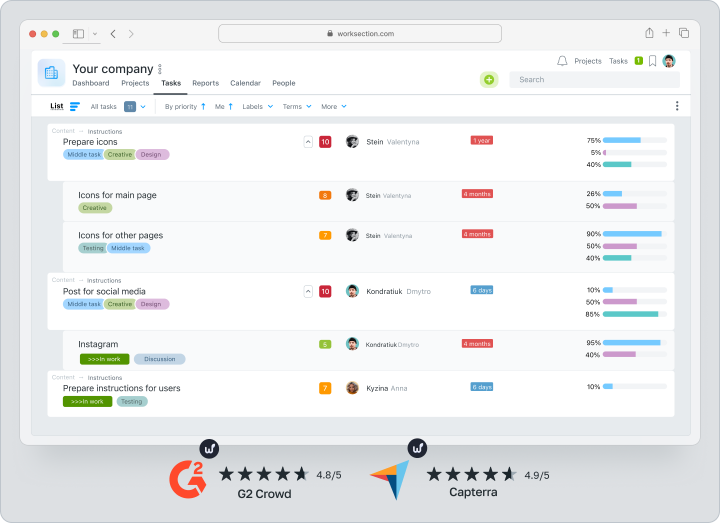
Bitrix24
Bitrix24 markets itself as an all-in-one “combiner,” offering CRM, telephony, chat, and tasks. Prebuilt bots move deals automatically, trigger email sequences, and assign owners. The free tier offers 5 GB of storage and limited functionality, while full automation unlocks at the “Company” plan starting at ₽7 490 per month for 50 users. Bitrix24’s strong suit is deep integration with 1C and Russian payment systems; its weakness is a cluttered interface that can overwhelm newcomers.
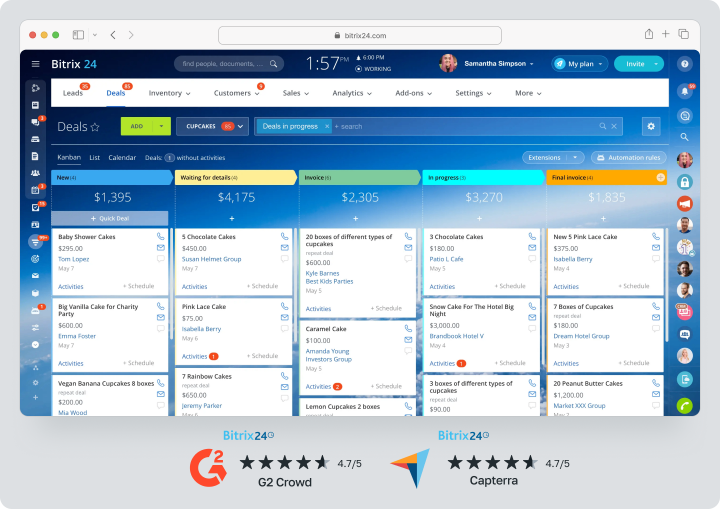
ClickUp
ClickUp focuses on flexibility: each space can have unique statuses, fields, and automation rules. Users switch between list, Kanban, calendar, mind-map, or Gantt in one click. The free version already supports unlimited tasks, but the time tracker, goals, and project portfolios appear in the “Unlimited” plan at $7 per user per month. The interface is English-only, yet the API and 1 000+ integrations via Zapier make up for it. Teams praise ClickUp’s versatility but note a sometimes complex navigation.
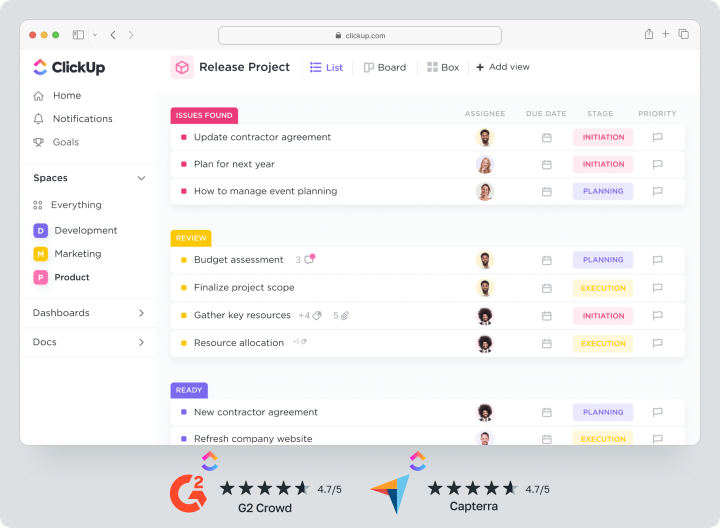
Asana
Asana is known for its clean visual approach: every project can be viewed as a list, board, or timeline. Templates help with marketing campaigns, events, and product sprints. Automation relies on “if-then” rules, and workload reports track staff capacity. Integrations include Slack, Google Drive, Zapier, and Zoom. The “Premium” plan costs $10.99 per user per month (annual billing). The main drawback: no built-in CRM, so you must connect sales through external plugins.
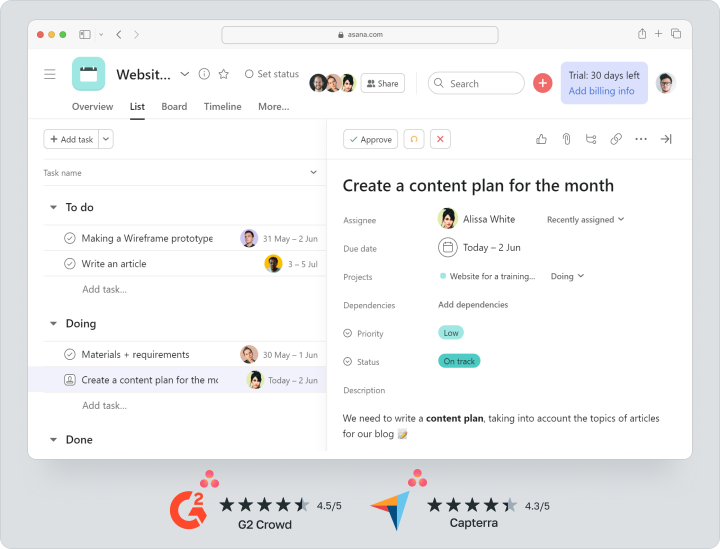
Trello
Trello remains the benchmark for simple Kanban. Boards consist of cards that move between columns, and extra features arrive via Power-Ups. The free tier fits small teams with up to ten boards and basic Butler automations. Upgrading to “Standard” costs $5 per user. Trello’s low learning curve is a plus, while limited analytics and the absence of a full CRM are the trade-offs.
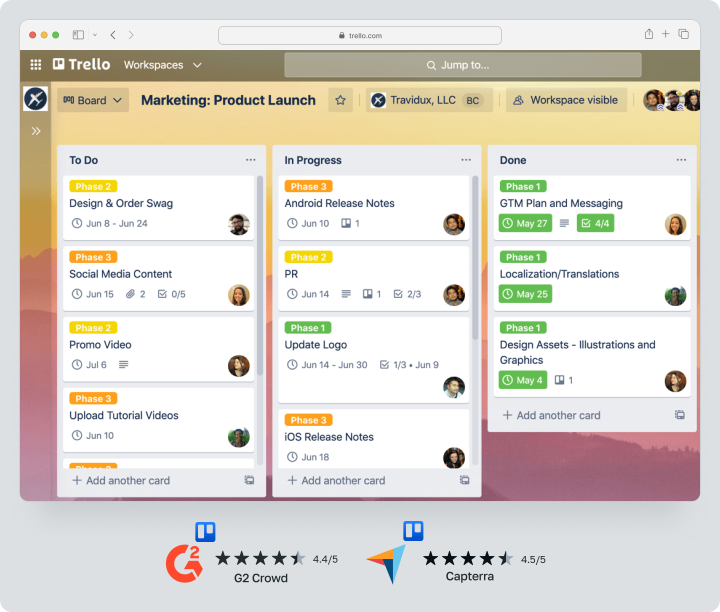
Zoho CRM
Zoho CRM zeroes in on sales but expands into task management through Zoho Projects and support via Zoho Desk. It offers pipelines, lead scoring, AI forecasts, and multichannel outreach (email, phone, messengers). The “Standard” package is $14 per user, or you can unlock dozens of apps in Zoho One for $45 per month. The downside: features are spread across modules, and some Russian localization is partial.

Notion
Notion merges knowledge bases, documents, and tasks. Users build pages, databases, and boards, turning the service into a “digital Lego set.” The free version allows unlimited members, but files above 5 MB require the “Plus” plan at $8 per user. Flexibility is the core benefit; the lack of a ready-made CRM or time tracker means you’ll assemble those pieces yourself or rely on community templates.
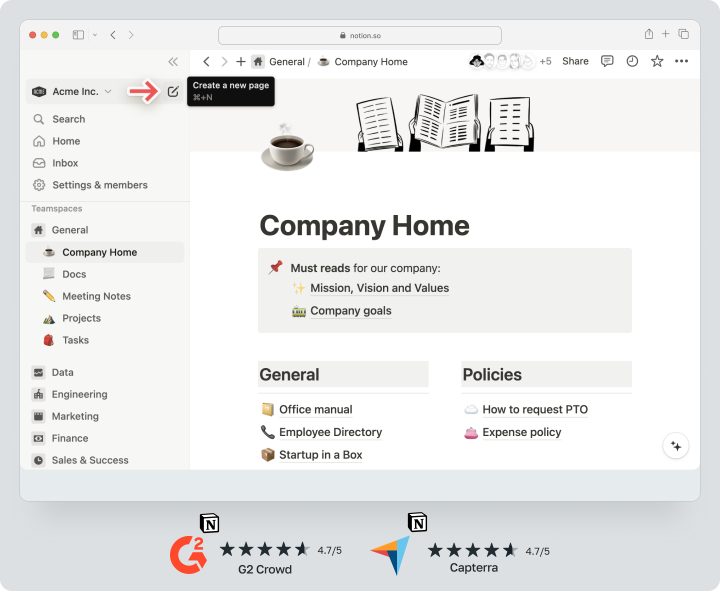
Basecamp
Basecamp emphasizes minimalism: each workspace includes a to-do board, chat, calendar, file storage, and docs. Pricing is flat — $15 per user per month with no project limits. Larger firms can choose Basecamp Pro Unlimited at $299 per month “for the whole company.” Reports are basic and there’s no CRM, but for internal communication and project messaging, it often suffices.
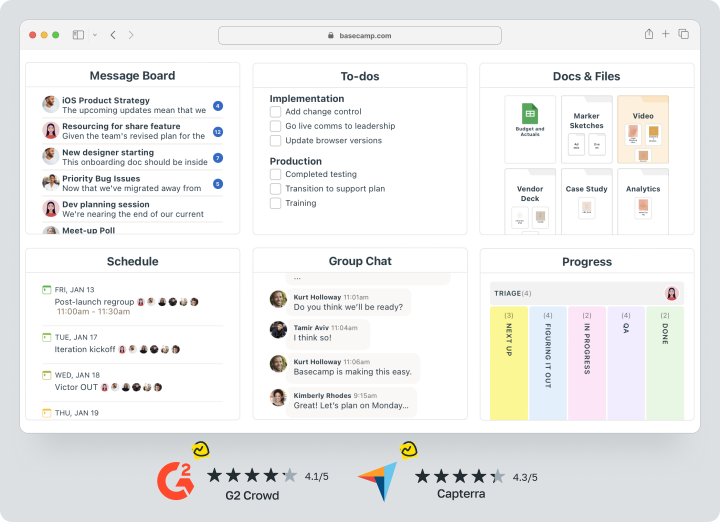
Pipedrive
Pipedrive is a focused sales CRM. Deals move through Kanban stages, with custom fields, email automation, and revenue forecasting. It integrates with WhatsApp, Zoom, Stripe, and more, offers mobile apps, and has an internal add-on marketplace. The popular “Advanced” tier costs $24.90 per user per month. The interface is clean, but task management is rudimentary — complex projects can feel cramped.
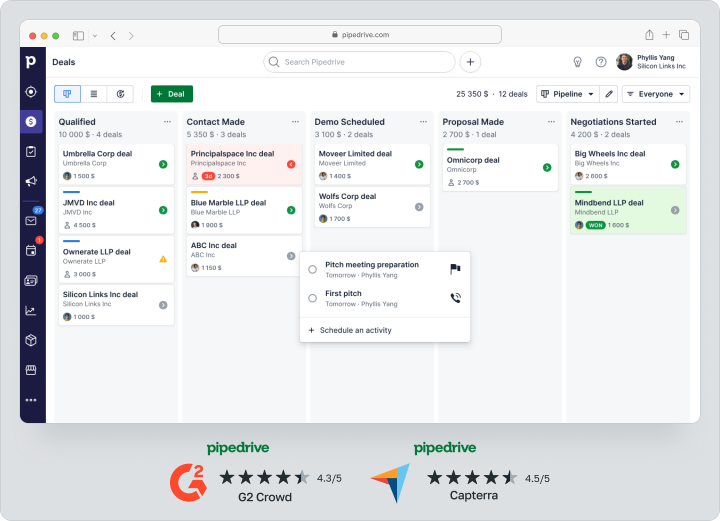
Monday.com
Monday.com blends CRM modules with visual project boards. Automations follow “trigger + condition + action” logic, and dashboard widgets pull data from every department. The “Standard” plan is $10 per user per month (annual, minimum three seats). The service supports English and Russian, has 200+ integrations, and a robust GraphQL API. Downsides: granular row-level permissions are tricky, and the “Enterprise” tier is considerably pricier.
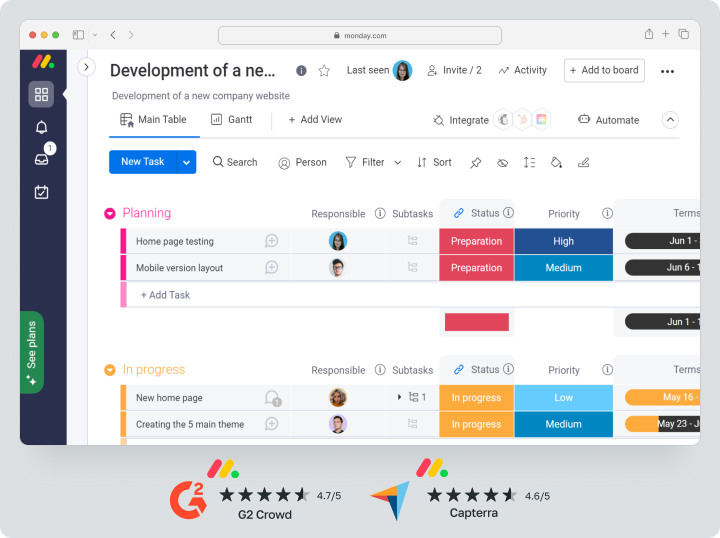
Comparison Table of the Best Megaplan Alternatives
| Service | CRM Features | Task Management | Visualization (Kanban/Gantt) | Reports & Time Track | Multichannel | Base-Plan Price* |
| Worksection | Built-in mini-CRM | Lists, Kanban, Gantt, Calendar | All available | Reports + built-in tracker | E‑mail, API, Webhooks | €49 per team (≤ 25) |
| Bitrix24 | Full CRM | Lists, Kanban, Gantt | All available | Detailed, no tracker | Telephony, chat, socials | ₽0 – 7 490/month (50 users) |
| ClickUp | Pipeline via views | Full stack | Kanban, Gantt, mind-map | Tracker, goals | 1 000+ integrations | $7 user/month |
| Asana | None built-in | Lists, boards, Gantt | Kanban, Gantt | Workload reports | Integrations via Zapier | $10.99 user/month |
| Trello | Power-Up CRM | Kanban | Kanban | Butler automations | Power-Ups | $5 user/month |
| Zoho CRM | Full CRM | Via Zoho Projects | Kanban, timeline | Analytics, AI forecast | Email, phone, socials | $14 user/month |
| Notion | Templates | Lists, boards | Kanban | No built-in | Zapier integrations | $8 user/month |
| Basecamp | None | Lists, boards | Kanban, calendar | Simple logs | Chat, e‑mail forward | $15 user/month |
| Pipedrive | Full CRM | Basic activities | Deal Kanban | Detailed analytics | Messengers, telephony | $24.90 user/month |
| Monday.com | Ready module | Lists, boards, Gantt | All available | Dashboard widgets | Integrations + API | $10 user/month |
*Prices are valid as of 12 June 2025 with annual billing and may change.
Which Platform Should You Choose in 2025?
If you’re an agency or IT studio running project-based, hourly work, the top “Megaplan replacement” is Worksection: the flat team price, built-in time tracker, and visual tools cover everything out of the box. If you need a unified “CRM + tasks + telephony” hub, Bitrix24 or Monday.com are stronger on multichannel sales. Start-ups craving flexibility and no-code automation often pick ClickUp. Companies focused solely on pipeline management gravitate toward Pipedrive or Zoho CRM. Those who love minimalism and visual simplicity feel at home in Trello or Basecamp. Always test the trial, benchmark response times with 10 000+ tasks, and only then lock in your budget for a new tool.
Frequently Asked Questions (FAQ)
Which Megaplan alternative is best for agencies?
Agencies most often select Worksection or ClickUp. Worksection wins with its flat pricing and built-in time tracking, while ClickUp delivers near-limitless status and automation customization.
Are there free Megaplan alternatives?
Trello remains the most popular free option, Bitrix24 offers unlimited users on its basic plan (with limits), and Worksection provides a generous trial and an entry-level plan for small teams.
How does Worksection differ from Megaplan?
Worksection spins up quickly in AWS-EU, delivers Kanban and Gantt “out of the box,” includes a native time tracker, and offers transparent pricing with no hidden fees. Teams therefore gain a modern “CRM alternative” and task manager without the pain points that drive them away from Megaplan. Last updated: 12 June 2025.